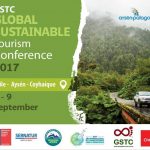GSTC annual meet
 GSTC Attracts Global Participation to Address Sustainable Destinations
GSTC Attracts Global Participation to Address Sustainable Destinations
By David Randle, Contributor Director Sustainable Tourism USF Patel College of Globals Sustainability & President & CEO of the WHALE Center From Huffington Post
The GSTC (Global Sustainable Tourism Council) just completed its annual meeting in Aysen, Patagonia, Chile. During the meeting I received the honor of being appointed to the GSTC Board of Directors.
The conference included 250 participants from 30 countries from North America, the Caribbean, Central America, South America, Africa, Europe, Asia, and Australia.
The Conference included 250 participants from international and domestic tourism stakeholders involved in the development and promotion of sustainable tourism; including public sector, hotels, tour operators, academia, development agencies, NGOs, consultants, and more. Along with Chilean participants, international participants came from 30 countries inlcuding: Australia, Botswana, Canada, Hong Kong, Cayman Islands, Colombia, Costa Rica, France, Greece, Guatemala, Mexico, Netherlands, Peru, Portugal, Russia, Spain, Taiwan, UK, USA, and more.
The conference was a huge success. Roi Ariel, GSTC General Manager stated:
“”The interest and thirst for knowledge of sustainable tourism by Chileans (and internationals) was incredible, all tickets were sold out 2 months before the Conference, so we also live-broadcasted the conference, allowing hundreds more to tune in from different countries.”
Some comments from participants included:
“A great meeting in Patagonia, thanks to the organization and to all people who made this conference possible,” Says Felipe Muñoz Narbona, Director of Ecomapu Valparaíso, a sustainable tour operator certified by Chile’s Sello S (a GSTC-Recognized Standard).
“The conference gave us the opportunity to connect with people who understand and work the sustainable tourism, not as an alternative way to make the things, rather as an opportunity and need for the future of the the world tourism,” Felipe explained.
“Thank you very much for transmitting, it’s a great contribution,” said Paola Molina O’Ryan, a Chilean Architect who watched the entire conference through the live broadcasting.”
“For me as a sustainable tourism student, the GSTC conference was the wonderful opportunity to meet with sustainable tourism professionals, who are passionate to address in sustainability in the real world. All the information from the conference was useful for all participants including not only professionals working in tourism sector but also sustainability leaners such as students and local people. I really appreciate the organizers and speakers of the conference.“ – Takafumi Minotani
As in every GSTC Conference, new opportunities and partnerships were developed, some were already announced during the Conference, such as an MOU between GSTC members Sustainable Riviera Maya (Mexico) and Regenera NGO (Chile)”
The theme of the conference was “Towards More Sustainable Destinations: Management, Marketing, and Awareness” which is crucial to the furthering of sustainable tourism around the globe.
Tourism is the world’s largest industry accounting for about 10% of the world’s GDP and responsible for employing about 12% of the work force. It is also the world’s fastest growing industry with projections to increase from 1 billion to 1.6 billion international visitors this decade.
With this continued increase of visitors some tourist areas in the world are starting to feel the pressure. One of the featured presenters was Jonathan Tourellot, Member of the GSTC Destinations Working group and National Geographic Fellow Emeritus who spoke to this issue of Tourism Overuse.
Jonathan refers readers to two articles to better understand this issue. The first “Tourism kills neighbourhoods: how do we save cities from the city break?” by Elle Hunt, and the second “Only governments can stem the tide of tourism sweeping the globe” by Elizabeth Becker.
In her article Becker states:
“Only governments can handle runaway tourism. Few major industries fall so squarely into their hands – local, regional and national. Governments decide who is eligible for visas: how many cruise ships, airlines and trains can bring in visitors, how many hotels receive building permits, how many beaches are open to development, how many museums and concert halls are open, even how many farmers receive subsidies to raise food for the restaurants and cafes that tourists frequent.”
Jonathan points out that the GSTC is addressing this issue through its new Destination Criteria. He states: “To help cope with tourism impacts and general stewardship , a council type of arrangement is called for in GSTC’s destination Criterion A2, which reads:
“The destination has an effective organization, department, group, or committee responsible for a coordinated approach to sustainable tourism, with involvement by the private sector and public sector. This group is suited to the size and scale of the destination, and has defined responsibilities, oversight, and implementation capability for the management of environmental, economic, social, and cultural issues. This group’s activities are appropriately funded.”
While few of these types of groups currently exist the GSTC is now working to identify the best practices and models for others to follow.
The choices Destinations make has the potential of leading the world to a more sustainable future where we can live safely within the planetary boundaries. On the other hand if sustainable choices are not made tourism’s large footprint may accelerate the impacts from issues such as climate change, ocean acidification, nitrogen / phosphorus overload, depletion of fresh water resources, ozone depletion, harmful land use chances such as deforestation, aerosol loading in the atmosphere, chemical pollution, and loss of biodiversity.
The GSTC has developed global criteria to assist the tourism industry sectors of tour operators, hotels, and resorts, and destinations to operate more sustainably so that there impacts are more positive rather than negative.
The GSTC criteria (https://www.gstcouncil.org/gstc-criteria/) includes four broad categories of four pillars that are the base of sustainable tourism. These include:
Sustainable Management
Socioeconomic Impacts
Cultural Impacts
Environmental impacts (including consumption of resources, reducing pollution, and conserving biodiversity and landscapes)
Through a global criteria that includes minimum requirements in the above four areas, the pathway is set for the tourism industry to continue to improve the sustainability of its operations and practices.
At the GSTC meeting in Chile the focus was on Destinations and included such topics as:
Certifications of sustainability in travel and tourism
Marketing sustainable tourism
Sustainable visitor management practices
Municipalities managing for sustainable tourism
Destination management for climate change adaptation
Sustainable tourism awareness and education
Sustainable hotel management
Sustainable food in the tourism industry
Ecotourism and community-based tourism
Indigenous tourism
It was exciting to learn of many exciting projects from around the world at the GSTC Conference.
I was pleased to share some of the best practices from Destinations such as Walt Disney World, Anna Maria Island, and the soon to be opened Villages Nature, Paris, each of which offer examples of best practices for other destinations to learn from. GSTC attendees were invited to visit our Sustainable Tourism Observatory in later October to participate in the Choices for Our Sustainable Tourism Future Conference where we can exchange our best practices.
The last evening of the conference we were treated to a dinner at favorite local spot for celebration. During the dinner conversation I learned from some of the locals of their pride in working toward sustainable and responsible tourism and the community efforts that have been developed to do so.
The last day of the conference we were treated to a visit of the Cereo Castillo National Preserve in Chile (where we were able to visit the archeological museum and do a little hiking in the beautiful mountains of Southern Chile. The scenery was spectacular.
As with previous GSTC Conferences, the carbon footprint of the event was offset to become a ‘carbon neutral event’ by the scheme CO2 NEUTRAL SEAL through sponsorship of Green Evolution SA. Other sustainable-events practices were carried out, such as reducing paper and plastic usage to a minimum: badges were made of recycled paper, brochures were not printed at all but were being provided through pdf files, no plastic bottles were used during the conference. Vegetarian meal was the default option, and all participants traveled by buses to offsite events.
The local economy also benefited from the conference from the use of several hotels for accommodations purchase of food from several restaurants and local crafts and art were featured for sell in the conference lobby each day.
I look forward to next years GSTC meeting of GSTC and hope that you will join us. Next years location has not yet been announced but you can keep informed by signing up for the GSTC newsletter
Dr. David W. Randle – Director USF Patel College of Global SustainabilitySustainable Tourism, Managing Director International Ocean Institute Waves of Change Blue Community Initiative and President & CEO WHALE Center
Follow David Randle on Twitter
IMAGES;
GSTC IN CHILE – AYSEN – COYHAIQUE
GSTC MEETING
JONATHAN TOURELOTT
DR. DAVID RANDLE
CLOSING SESSION AT GSTC
CLOSING SESSION AT GSTC
For more on this story go to: http://www.huffingtonpost.com/entry/gstc-attracts-global-participation-to-address-sustainable_us_59c6e50ae4b08d6615504321










